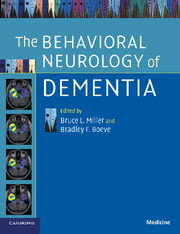Book contents
- Frontmatter
- Contents
- List of contributors
- Section 1 Introduction
- Section 2 Cognitive impairment, not demented
- 12 Cerebrovascular contributions to amnestic mild cognitive impairment
- 13 Mild cognitive impairment
- 14 Mild cognitive impairment subgroups
- 15 Early clinical features of the parkinsonian-related dementias
- 16 Dementia treatment
- 17 Dementia and cognition in the oldest-old
- Section 3 Slowly progressive dementias
- Section 4 Rapidly progressive dementias
- Index
- References
16 - Dementia treatment
Published online by Cambridge University Press: 31 July 2009
- Frontmatter
- Contents
- List of contributors
- Section 1 Introduction
- Section 2 Cognitive impairment, not demented
- 12 Cerebrovascular contributions to amnestic mild cognitive impairment
- 13 Mild cognitive impairment
- 14 Mild cognitive impairment subgroups
- 15 Early clinical features of the parkinsonian-related dementias
- 16 Dementia treatment
- 17 Dementia and cognition in the oldest-old
- Section 3 Slowly progressive dementias
- Section 4 Rapidly progressive dementias
- Index
- References
Summary
Introduction
There is reason for optimism about future treatment of the most common causes of dementia. Advances in understanding the molecular pathologies that underlie the most common causes of neurodegenerative dementia are rapidly being translated into new treatments. At the same time, basic investigations into the neurophysiology of synaptic transmission, neuronal growth, development and survival have identified new receptors, genes and intracellular second messenger cascades that may serve as targets for new treatments for dementia. Whereas most currently approved medications that are used to treat dementia are effective only in ameliorating the symptoms of disease, in the near future, medications that modify the course of the disease by protecting the brain from dementia-related pathology may be available. New diagnostic tests will also help to identify accurately who is likely to benefit from such treatment and monitor their treatment response. This chapter will review the currently available treatments for the most common forms of dementia, focusing on clinical syndromes that are readily identifiable by practicing clinicians, as well as new treatments that are currently under investigation or new avenues for treatment suggested by recent advances in understanding the molecular pathologies of these disorders.
- Type
- Chapter
- Information
- The Behavioral Neurology of Dementia , pp. 213 - 253Publisher: Cambridge University PressPrint publication year: 2009
References
- 2
- Cited by



